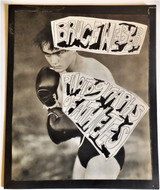MUGEN-NO-MICHI / NOH MASKS by YUISEI & YUISHU MORI - 1984
Mugen-no-Michi (Art Unattainable) - Noh Mask Exhibition
edited by Toru Ishikawa
photos by Fumio Dodo
Album of photos published to accompany 1984 New York exhibition of traditional-style Japanese Noh Masks carved by Yuisei and Yuishu Mori.
Text is in English and Japanese. Assumed publication date: 1984.
Hardback is overall in VERY GOOD+ condition.
- Traditional Japanese binding showcases a handsome collection of annotated images.
- Title on cover is in Japanese calligraphy on special paper, pasted on fabric.
- Covers are wrapped in decorated cloth, with some fading along perimeters. See Photos.
- Binding is secure, free of creasing, and feels unread.
- Title page has faint lengthwise crease.
- Inside pages are a sturdy, quality parchment, bound in the Japanese style of folded leaves.
- Handmade paper is free of writing and intentional marks.
- Book may exhibit additional minor signs of age or wear.
- CR2012x
88 pages, with 44 photos and descriptions. 7.5 x 10.5 inches.
Classic Japanese / ”oriental” binding with 2 purple ribbons, each with 3 knots, yet is read from the right (Western). Boards are covered in floral print fabric that's tan on purply-brown metallic background. Book is arranged with a vibrant photo pasted on left, and elegant description on right.
Introduction by Masaharu Gotoda, Chief of Cabinet Secretariat. Includes photos and bio of the artists.
Noh is a major form of classical Japanese dance-drama that has been performed since the 14th century, and still is today. It is characterized by the integration of masks, costumes and various props in a dance-based performance, requiring highly trained actors and musicians. The narrative is often based on tales from traditional literature with a supernatural being transformed into human form as a hero narrating a story.
Noh masks are stylized, and highly prized. They are used to signify the characters' gender, age, and social ranking. By wearing masks the actors may portray youngsters, old men, female, or nonhuman (divine, demonic, or animal) characters. Typically, only the main actor wears a mask in most plays. There are approximately 450 different masks mostly based on sixty types, all of which have distinctive names. [Wikipedia]
#panoplybooks #rarebooks #bookboutique #collectiblebooks #antiquebooks #vintagebooks #bookstore
















![44 WILDE 1944, by John Wilde - 1984 [The Perishable Press] 44 WILDE 1944, by John Wilde - 1984 [The Perishable Press]](https://cdn11.bigcommerce.com/s-5sppbk3px9/images/stencil/160w/products/8937/84777/JohnWilde11__69346.1703785498.jpg?c=2)
![MISTER X, by Jaime and Gilbert Hernandez - 1984 [Complete 1st Series] MISTER X, by Jaime and Gilbert Hernandez - 1984 [Complete 1st Series]](https://cdn11.bigcommerce.com/s-5sppbk3px9/images/stencil/160w/products/8685/82210/MisterX2__55763.1684352305.jpg?c=2)